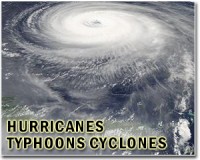| . |  |
. |
Beijing (AFP) Oct 20, 2010 Chinese authorities on Wednesday ordered fishermen back to shore and halted rail services as Typhoon Megi, the strongest northwest Pacific storm since 1990, barrelled towards the mainland. Megi has already wreaked havoc in the Philippines, killing at least 19 people and leaving relief workers scrambling to deliver aid to devastated, remote towns. It is now making its way towards southern China, where it is expected to make landfall in the southern province of Guangdong on Saturday, the National Meteorological Centre said. "We expect that the strong winds and torrential rain brought by Megi will increase the probability of geological disasters happening in the south such as floods, land and mudslides," the centre warned. Hong Kong's observatory said Thursday the storm was showing "signs of intensification" and said vessels from the territory should avoid the open sea. Fishing boats in the southern province of Guangdong and neighbouring Fujian have been told not to leave port, and those already at sea have been ordered back to shore, the official China Daily newspaper said. China's state-run Xinhua news agency, citing the State Oceanic Administration, has said that Guangdong could see storm-triggered waves of up to seven metres (21 feet). Reservoirs and hydroelectric stations in Guangdong have been put on high alert, and local flood control officials have been told to ensure the safety of venues for the upcoming Asian Games in the provincial capital Guangzhou. In Hainan, which is still reeling from recent severe flooding, authorities halted some passenger train services, and residents in the island's capital Haikou have flocked to supermarkets to stock up on goods, state media said. In Sanya, a resort city in Hainan, billboards were being taken down to remove potential threats to people and vehicles, the China Daily said. China has issued an early disaster warning for Fujian, Guangdong, Hainan and the coastal Guangxi region, calling on local officials to ensure that people in low-lying areas are evacuated early. About 140,000 people have already been moved from their homes in Hainan due to the recent torrential rains and flash flooding. This summer, China was hit by its worst floods in more than a decade, with more than 4,300 people dead or missing -- including 1,500 people killed in one devastating mudslide in the northwestern province of Gansu in August. Megi, which according to the Hong Kong Observatory was packing winds of 185 kilometres (115 miles) an hour late Wednesday, is the strongest storm seen worldwide so far this year. In the Philippines, the typhoon smashed into mostly farming and fishing areas of northern Luzon with gusts of 260 kilometres an hour on Monday. The three million residents of Isabela province and other areas of the Cagayan Valley farming region were the worst hit. Isabela governor Faustino Dy said that residents in three coastal towns had suffered massive damage to their homes and were left with limited food supplies after huge waves washed away roads. "Their food supply is only up to Sunday. But going there is very difficult. There is no road to reach them," Dy told reporters in Cauayan, the closest city to the worst-hit towns. The first level of a four-step storm alert remained in effect over several provinces in the northern Philippines due to continuing rain.
Share This Article With Planet Earth
Related Links Bringing Order To A World Of Disasters When the Earth Quakes A world of storm and tempest
 Deadly Typhoon Megi dumps heavy rains on Philippines
Deadly Typhoon Megi dumps heavy rains on PhilippinesBaguio, Philippines (AFP) Oct 19, 2010 Thousands of people sheltered in evacuation centres as Typhoon Megi dumped heavy rains across the Philippines' main island on Tuesday, a day after the ferocious storm took at least 14 lives. Schools were suspended in Manila and other parts of Luzon island amid fears of flash floods, while rescue workers tried to reach villagers stranded in remote areas that were cut off by the typhoon. " ... read more |
|
| The content herein, unless otherwise known to be public domain, are Copyright 1995-2010 - SpaceDaily. AFP and UPI Wire Stories are copyright Agence France-Presse and United Press International. ESA Portal Reports are copyright European Space Agency. All NASA sourced material is public domain. Additional copyrights may apply in whole or part to other bona fide parties. Advertising does not imply endorsement,agreement or approval of any opinions, statements or information provided by SpaceDaily on any Web page published or hosted by SpaceDaily. Privacy Statement |